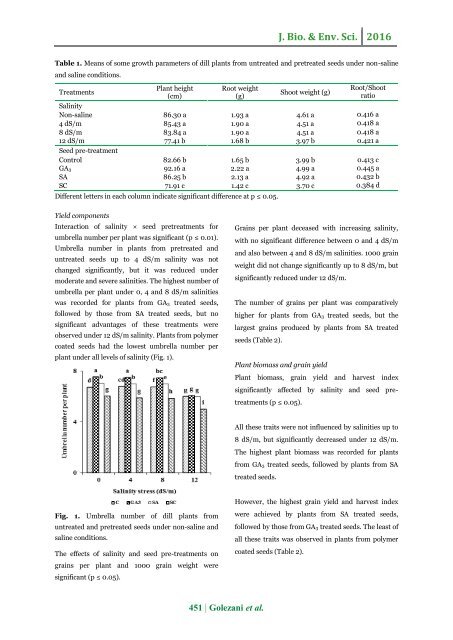Influence of seed pretreatments on growth and yield parameters of dill under salt stress
Abstract An experiment was carried out in 2015 at the University of Tabriz, Iran, to evaluate the effects of different seed pre-treatments (Control, 1 mM GA3 and SA and polymer seed coating) on growth and yield parameters of dill (Anethum graveolens L.) under a non-saline and three saline (4, 8 and 12 dS/m NaCl) conditions. This experiment was arranged as factorial, based on RCB design with three replications. Means of plant height, shoot and root weight, plant biomass, umbrella number per plant, 1000 grain weight, grain yield and harvest index were statistically similar up to 8 dS/m NaCl salinities, but significantly decreased under 12 dS/m salinity. Seed polymer coating accelerated the deleterious effects of salinity and generally led to poor performance of plants under salt stress. However, most of the growth and yield parameters of dill were improved as a result of seed pretreatment by gibberellic acid (GA3) and salicylic acid (SA). The highest grain yield per plant and harvest index were recorded for plants from SA treated seeds, followed by those from GA3 treated seeds.
Abstract
An experiment was carried out in 2015 at the University of Tabriz, Iran, to evaluate the effects of different seed pre-treatments (Control, 1 mM GA3 and SA and polymer seed coating) on growth and yield parameters of dill (Anethum graveolens L.) under a non-saline and three saline (4, 8 and 12 dS/m NaCl) conditions. This experiment was arranged as factorial, based on RCB design with three replications. Means of plant height, shoot and root weight, plant biomass, umbrella number per plant, 1000 grain weight, grain yield and harvest index were statistically similar up to 8 dS/m NaCl salinities, but significantly decreased under 12 dS/m salinity. Seed polymer coating accelerated the deleterious effects of salinity and generally led to poor performance of plants under salt stress. However, most of the growth and yield parameters of dill were improved as a result of seed pretreatment by gibberellic acid (GA3) and salicylic acid (SA). The highest grain yield per plant and harvest index were recorded for plants from SA treated seeds, followed by those from GA3 treated seeds.
You also want an ePaper? Increase the reach of your titles
YUMPU automatically turns print PDFs into web optimized ePapers that Google loves.
J. Bio. & Env. Sci. 2016<br />
Table 1. Means <str<strong>on</strong>g>of</str<strong>on</strong>g> some <strong>growth</strong> <strong>parameters</strong> <str<strong>on</strong>g>of</str<strong>on</strong>g> <strong>dill</strong> plants from untreated <strong>and</strong> pretreated <str<strong>on</strong>g>seed</str<strong>on</strong>g>s <strong>under</strong> n<strong>on</strong>-saline<br />
<strong>and</strong> saline c<strong>on</strong>diti<strong>on</strong>s.<br />
Treatments<br />
Plant height<br />
(cm)<br />
Root weight<br />
(g)<br />
Shoot weight (g)<br />
Root/Shoot<br />
ratio<br />
Salinity<br />
N<strong>on</strong>-saline 86.30 a 1.93 a 4.61 a 0.416 a<br />
4 dS/m 85.43 a 1.90 a 4.51 a 0.418 a<br />
8 dS/m 83.84 a 1.90 a 4.51 a 0.418 a<br />
12 dS/m 77.41 b 1.68 b 3.97 b 0.421 a<br />
Seed pre-treatment<br />
C<strong>on</strong>trol 82.66 b 1.65 b 3.99 b 0.413 c<br />
GA3 92.16 a 2.22 a 4.99 a 0.445 a<br />
SA 86.25 b 2.13 a 4.92 a 0.432 b<br />
SC 71.91 c 1.42 c 3.70 c 0.384 d<br />
Different letters in each column indicate significant difference at p ≤ 0.05.<br />
Yield comp<strong>on</strong>ents<br />
Interacti<strong>on</strong> <str<strong>on</strong>g>of</str<strong>on</strong>g> salinity × <str<strong>on</strong>g>seed</str<strong>on</strong>g> <str<strong>on</strong>g>pretreatments</str<strong>on</strong>g> for<br />
umbrella number per plant was significant (p ≤ 0.01).<br />
Umbrella number in plants from pretreated <strong>and</strong><br />
untreated <str<strong>on</strong>g>seed</str<strong>on</strong>g>s up to 4 dS/m salinity was not<br />
changed significantly, but it was reduced <strong>under</strong><br />
moderate <strong>and</strong> severe salinities. The highest number <str<strong>on</strong>g>of</str<strong>on</strong>g><br />
umbrella per plant <strong>under</strong> 0, 4 <strong>and</strong> 8 dS/m salinities<br />
was recorded for plants from GA3 treated <str<strong>on</strong>g>seed</str<strong>on</strong>g>s,<br />
followed by those from SA treated <str<strong>on</strong>g>seed</str<strong>on</strong>g>s, but no<br />
significant advantages <str<strong>on</strong>g>of</str<strong>on</strong>g> these treatments were<br />
observed <strong>under</strong> 12 dS/m salinity. Plants from polymer<br />
coated <str<strong>on</strong>g>seed</str<strong>on</strong>g>s had the lowest umbrella number per<br />
plant <strong>under</strong> all levels <str<strong>on</strong>g>of</str<strong>on</strong>g> salinity (Fig. 1).<br />
Grains per plant deceased with increasing salinity,<br />
with no significant difference between 0 <strong>and</strong> 4 dS/m<br />
<strong>and</strong> also between 4 <strong>and</strong> 8 dS/m salinities. 1000 grain<br />
weight did not change significantly up to 8 dS/m, but<br />
significantly reduced <strong>under</strong> 12 dS/m.<br />
The number <str<strong>on</strong>g>of</str<strong>on</strong>g> grains per plant was comparatively<br />
higher for plants from GA3 treated <str<strong>on</strong>g>seed</str<strong>on</strong>g>s, but the<br />
largest grains produced by plants from SA treated<br />
<str<strong>on</strong>g>seed</str<strong>on</strong>g>s (Table 2).<br />
Plant biomass <strong>and</strong> grain <strong>yield</strong><br />
Plant biomass, grain <strong>yield</strong> <strong>and</strong> harvest index<br />
significantly affected by salinity <strong>and</strong> <str<strong>on</strong>g>seed</str<strong>on</strong>g> <str<strong>on</strong>g>pretreatments</str<strong>on</strong>g><br />
(p ≤ 0.05).<br />
All these traits were not influenced by salinities up to<br />
8 dS/m, but significantly decreased <strong>under</strong> 12 dS/m.<br />
The highest plant biomass was recorded for plants<br />
from GA3 treated <str<strong>on</strong>g>seed</str<strong>on</strong>g>s, followed by plants from SA<br />
treated <str<strong>on</strong>g>seed</str<strong>on</strong>g>s.<br />
However, the highest grain <strong>yield</strong> <strong>and</strong> harvest index<br />
Fig. 1. Umbrella number <str<strong>on</strong>g>of</str<strong>on</strong>g> <strong>dill</strong> plants from<br />
untreated <strong>and</strong> pretreated <str<strong>on</strong>g>seed</str<strong>on</strong>g>s <strong>under</strong> n<strong>on</strong>-saline <strong>and</strong><br />
saline c<strong>on</strong>diti<strong>on</strong>s.<br />
The effects <str<strong>on</strong>g>of</str<strong>on</strong>g> salinity <strong>and</strong> <str<strong>on</strong>g>seed</str<strong>on</strong>g> pre-treatments <strong>on</strong><br />
were achieved by plants from SA treated <str<strong>on</strong>g>seed</str<strong>on</strong>g>s,<br />
followed by those from GA3 treated <str<strong>on</strong>g>seed</str<strong>on</strong>g>s. The least <str<strong>on</strong>g>of</str<strong>on</strong>g><br />
all these traits was observed in plants from polymer<br />
coated <str<strong>on</strong>g>seed</str<strong>on</strong>g>s (Table 2).<br />
grains per plant <strong>and</strong> 1000 grain weight were<br />
significant (p ≤ 0.05).<br />
451 | Golezani et al.





![Review on: impact of seed rates and method of sowing on yield and yield related traits of Teff [Eragrostis teff (Zucc.) Trotter] | IJAAR @yumpu](https://documents.yumpu.com/000/066/025/853/c0a2f1eefa2ed71422e741fbc2b37a5fd6200cb1/6b7767675149533469736965546e4c6a4e57325054773d3d/4f6e6531383245617a537a49397878747846574858513d3d.jpg?AWSAccessKeyId=AKIAICNEWSPSEKTJ5M3Q&Expires=1714024800&Signature=JJnpjne%2FP2qblBV1Mcl8cic5Qnc%3D)












